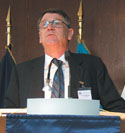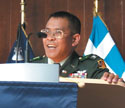NATO Ponders Web Effects
Military, industry experts review alliance Internet thrust. 
Dag Wilhelmsen, director of the NATO Consultation, Command and Control (C3) Agency, discusses how commercial interoperability standards are Web-focused under the umbrella of the NATO Network Enabled Capability.
The extensive thrust to Web services in the military is raising as many issues as promised new capabilities. The broad-based effort is complicated by nations’ differing approaches as well as by the rapid changes that characterize the 21st century Web.
The effect of the Web on current NATO operations was the focus of AFCEA’s 7th annual Supreme Headquarters Allied Powers Europe (SHAPE) conference. “Led by the Web?” was the theme of the May 30 event held in
Dag Wilhelmsen, director, NATO Consultation, Command and Control (C3) Agency, began the discussion by admitting that NATO continues to struggle with information management and distribution throughout the military structure. Since the 1980s, NATO has attempted to deal with interoperability through standardized agreements (STANAGs). Now, Web-focused commercial interoperability standards are under the umbrella of the NATO Network Enabled Capability (NNEC). The NNEC provides a service-oriented architecture with open and accepted standards that creates a federation of systems as opposed to of a system of systems. The architecture is nation-centric rather than a global information grid and incorporates legacy systems whereby metadata supports information sharing and exchange.
Web services are being used to develop a joint common operating picture (JCOP) along with traditional Web portal technologies. Network-enabled Joint Intelligence Surveillance and Reconnaissance (JISR) also is under development to deliver the right information in the right form to the right people at the right time. Wilhelmsen said he feels strongly that persistent and timely JISR creates the right environment for decision superiority. He noted that information assurance challenges require continuing research and development resources.
Rear Adm. Chris Parry, CBE, RN,
The admiral said that the Internet, abetted by globalized communications, would provide groups and individuals with greater visibility of the advantages and disadvantages of others. Physical separation would decline in significance. He drew attention to his organization’s Web site at www.dcdc-strate gictrends.org.uk, which provides an in-depth study of his key themes.
 |
| Col. Reynold Palaganas, USA, commander, NATO CIS Support Agency, allows that stovepiped policies, architectures and management approaches could be hindering the effectiveness of the NATO Response Force. |
The colonel also claimed that it was not possible to accelerate NNEC evolutionary programs or to improve NATO/national systems without firm mutual stakeholders’ national commitments to reduce technology and capability gaps. The colonel recommended that NATO C3 bodies focus on “quick wins” to aid the warfighter and that NATO must stay connected to industry forums such as the Network Centric Operations Industry Consortium (NCOIC).
Roger Mendham from Logica CMG discussed how the Internet has evolved since its inception 25 years ago. There were more than 747 million users in January 2007, and nearly 97 billion e-mail messages are sent each day. He explored how graphical user interfaces have moved from brick-size mobile telephones to the small devices used today, and he noted that these were part of the military inventory.
At the same time, bandwidth demands have increased. For example, about 78 percent of home Internet users in the
Marlin Forbes, vice president, Defense and International Services, Verizon Business, gave an overview of global industry trends. He stated that the backbones of strategic networks are being upgraded to ultra-long-haul fiber—which reduces network elements by as much as 70 percent—with access moving to a converged packet architecture. Voice networks would migrate to Internet protocols (IPs), and these fully meshed networks would have enhanced survivability. Verizon global networks already deliver services to more than 2,700 cities in more than 150 countries covering six continents.
Forbes noted that private IP alone is available in nearly 50 countries just in
After a review of the NATO command structure and the NNEC, Maj. Gen. Georges D’hollander, BEA, director, NATO Headquarters C3 Staff, posed the question, What is interoperability? He then considered three aspects—human, technical and procurement—over three epochs—yesterday, today and tomorrow. The challenge is that there are so many standards from which to choose, it is necessary to focus on the idea of net readiness and clear out the old standards. All hopes are pinned on the NNEC, and the general hopes to see positive convergence being achieved with a system of services and a federation of systems by 2010.
By achieving more interoperability, more data can be transferred and more information can be made available and exchanged, he explained. The general summed up his views by saying that if forces are driven by a mission to ensure provision of interoperability while handling transformation and NNEC evolution, then policy and other regulatory documents, including governance, are indeed biased by the need to take Web development into account.



